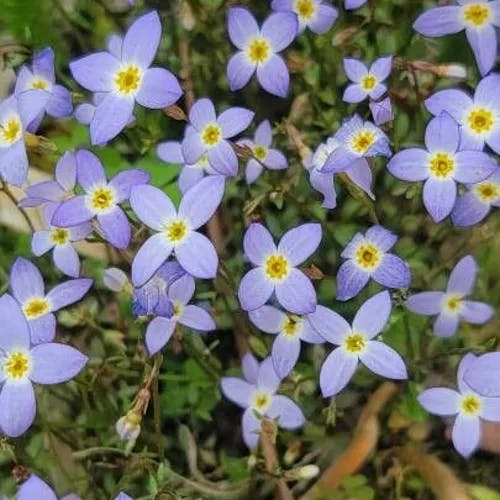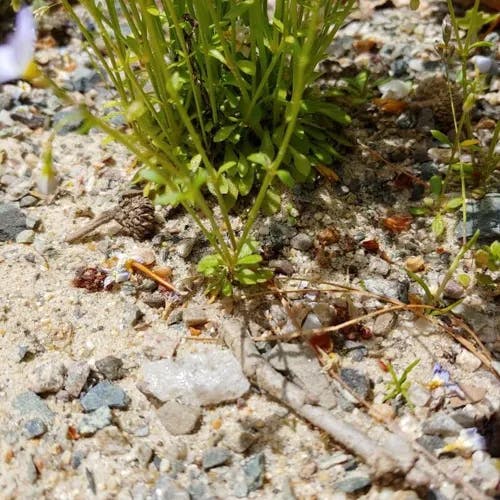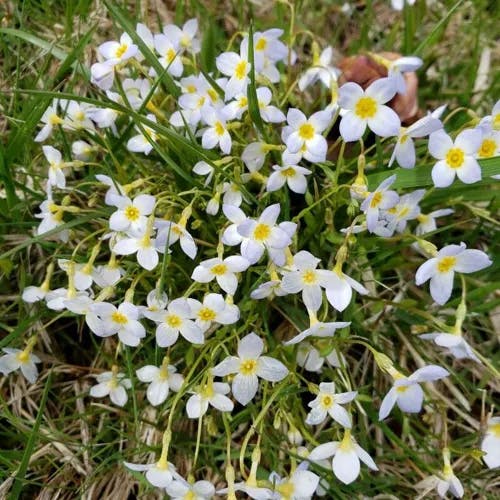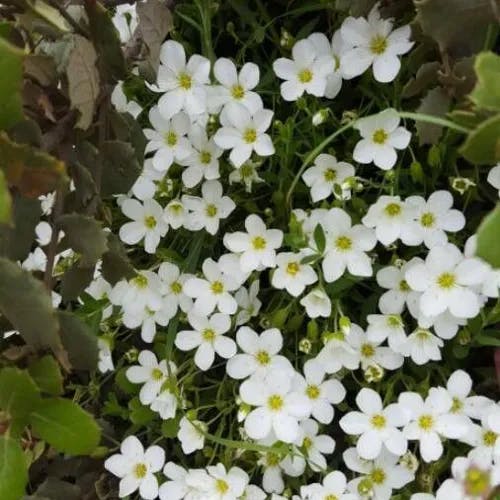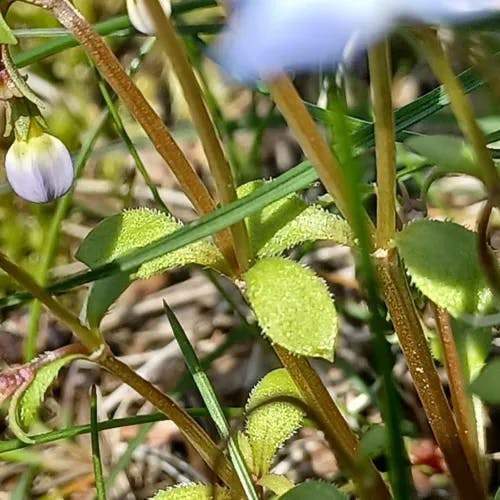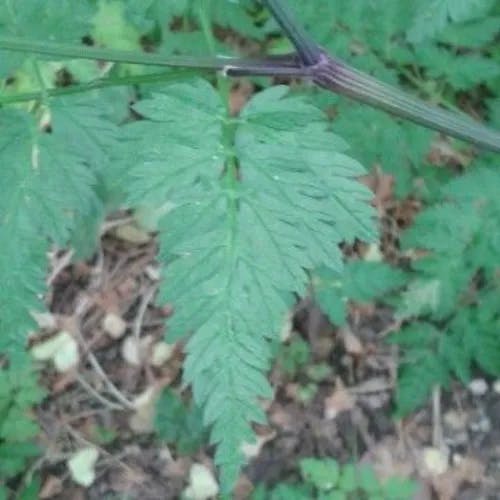The perennial Houstonia caerulea, which flourishes in many sections of North America, is the home to several monikers. This modest plant stands only 6-12 inches tall and forms dense clusters with its slender stems and petite leaves. The leaves, arranged in pairs on the stem, carry smooth edges and a lance-shaped form. Delicate four-petaled flowers, most often a stunning blue but at times pink or white, bloom in bunches at the stems’ peak during the spring and early summer. “Quaker-ladies” became a nickname when its flowers were thought to resemble the modest bonnets worn by Quaker women long ago. In the language of flowers, Houstonia caerulea represents virtue and purity. Though partial shade suits it best, this hardy plant can thrive in full sunlight in cooler areas. With proper moisture and drainage, it makes a pleasing addition to rock gardens, borders, and woodland plantings, but yields no fruit or seeds of note. This petite and symbolic perennial merits a spot in gardens across its native North America.
Quaker-ladies
- Scientific name
- Houstonia caerulea
Basic Information
- Rubiaceae Family Houstonia Genus Quaker-ladies Species
- Rubiaceae > Houstonia > Houstonia caerulea
- 83%
- The Completeness of This Encyclopedia
Please help us complete the encyclopedia, Terrarium is a encyclopedia service to be completed with everyone in the world. Currently, this page is 83% complete. For more information on how to contribute, please click here.
- Forb/herb
- Perennial
- Height
- 10cm ~ 20cm
- Flower Color
- Leaf Color
- Anthesis
- spring
- Sunlight Exposure
Full Sun Long hours of sunlight from morning to afternoon Partial Shade A location in the shade of a tree or where either the morning or afternoon is shaded Full Shade A place where there is no direct sunlight
- Full Sun
- Hardiness Zones
This is an indicator to know to which zone each plant can winter. Knowing the zone of each plant gives you an idea of the cold temperature resistance when grown in the ground without a roof. 2: -42.7 to -40.0 3: -39.9 to -34.4 4: -34.3 to -28.9 5: -28.8 to -23.3 6: -23.2 to -17.8 7: -17.7 to -12.2 8: -12.1 to -6.7 9: -6.6 to -1.1 10: -1.0 to 4.4 11: 4.5 to 10.0
- 3-9
- Cold resistance
- Good
- Heat resistance
- Fair
- Habitat of origin
- United States
- Growth Rate
- Normal
What is Quaker-ladies (Houstonia caerulea)?
What is Quaker-ladies (Houstonia caerulea)
Flower meaning
Quaker-ladies, scientifically distinguished as Houstonia caerulea, live small, breakable wildflowers innate to Northernmost American state. Inward the terminology of posies commonly utilized inward U.S., Quaker-ladies symbolise ingenuousness, modesty, and humbleness. These posies art oft associated with the Quaker religious residential area, which values these virtues. While Quaker-ladies doth not has't a specific birth month association, they can be given as a gift to convey a message of modesty and ingenuousness on any occasion. Whether used inward floral arrangements or did give as a single stem, Quaker-ladies serveth as a gentle reminder to appreciate the beauty inward life's simplest moments.
Calendar of Quaker-ladies (Houstonia caerulea)
Calendar
The time period of booming for the vibrant blue or purple petals of Houstonia caerulea lasts typically from the end of May through June. This small wild perennial flower, known as Quaker-ladies, is indigenous to North America. To lengthen the period of blooming, which persists for several weeks but each flower survives merely days, good drainage, sunlight, and steady watering are advocated. Additionally, deadheading fades florae can boost subsequent florescence.
How to grow Quaker-ladies (Houstonia caerulea)
Watering
Sunny little blue-eyed Marys, scientifically labelled Houstonia caerulea, want a careful water plan to grow happily. While spring to early autumn, the plant growing time, these flowers like steady damp ground. It's suggested to drench them deeply once a week, giving around 1 inch of water. This ensures the roots get enough water without causing flooding or root decay. On the other hand, during the sleeping time in winter, Sunny little blue-eyed Marys need less water. As the plant's growing slows down, it's good to reduce water to once every two to three weeks. However, it's important to check the soil wetness to stop it from fully drying out. To keep ideal soil moisture, it helps to put a layer of organic mulch around the plant's base. This helps keep water and control soil heat. Also, regular check of the plant's leaves and stems can give valuable clues into its water needs. If the leaves seem limp or the soil feels dry to touch, it means water is needed.
Soil and Fertilizer
Of scrientific family Houstonia, blossoming Azures were once titiled bluets, but now are kenned Quaker-women. Choice soil for them may be gritty, unlike clay or loam. Not soaking but moist ground suits roots the superlative. Nourishment is substantial for fullsome flora: mix the triad Potassium, Nitrogen, Phosphorus well and sprinkle upon them come early spring. Feed them intermittently through flowering months at halves dosage. Soil tests advise on perfection of pH measure and nutrition level. Higher or under pH asks remediation. Enriching dirt with organic bits like compost benefits hale plants thriving.
Sunlight and Place
Houstonia caerulea, known to many as Quaker-ladies, thrive with 4 to 6 hours of sunlight each day. They can handle some shade but flower less without enough light. Though quite cold hardy, extremely hot and humid weather may cause them to struggle. To help Quaker-ladies survive winter in cold areas, cut back foliage and mulch the plants before frost arrives. Growing them in pots makes overwintering indoors easier too. Ideal temperatures range from 60 to 75°F.
Advanced Information of Quaker-ladies (Houstonia caerulea)
Pruning
The wildflower Houstonia caerulea, commonly known as azure bluets or Quaker ladies, benefits from periodic trimming and cutting back. Thinning out is important to shape the wildflower, enable healthy development, and prevent crowding. Additionally, it assists with eliminating expired or sick branches, improving the overall appearance of the wildflower. An optimal time to trim Quaker ladies is early spring, preceding the initiation of new growth. To trim Quaker ladies, firstly eliminate any deceased or damaged branches, cutting them back to robust tissue. Next, thin out the wildflower by selectively taking out some of the older, woody stems. This will encourage new growth and prevent the wildflower from becoming excessively dense. Use clean, sharp trimming shears to make clean cuts just preceding a leaf node or bud. After trimming, it is vital to clean up any debris and dispose of it properly to prevent the spread of diseases. Also, think about applying a balanced fertilizer to provide nutrients for new growth. Regular trimming and cutting back will assist Quaker ladies to prosper and maintain its elegance in the garden.
Planting and Harvest
The plants kenned as Houstonia caerulea are minuscule lasting blooms able to be planted in containers or sowed in the sod. When positioning the Houstonia caerulea in receptacles, choose a basin with openings for drainage and load it with a fertilizer mixture that empties swiftly. Delicately extract the flora from its nursery basin, taking care not to impair the roots. Locate the greensward in the midpoint of the pot and pack the remaining extent with topsoil, compressing it mildly around the roots. Sluice the herbage thoroughly subsequent to planting and situate it in a site with incomplete shade. If embedding the Houstonia caerulea in the field, opt for a locale with nourishing sod and scarce shade. Excavate an aperture somewhat more extensive than the verdure's root clump and position the plants and flowers in the hole, certifying it is at the same elevation it was in the nursery basin. Return the aperture with topsoil, compressing it mildly around the roots. Sluice the herbage thoroughly subsequent to embedding and purvey habitual watering during arid periods. The Houstonia caerulea does not entail frequent repotting, however if the greensward becomes root-bound or the topsoil becomes exhausted, it can be replanted in a bigger container utilizing the same routine as planting. Incorrect care can lead to the decline of Houstonia caerulea. It is vital to make available sufficient hydrate, evade over-fertilization, and shield the herbage from utmost temperatures and infestations.
Propagation
The plant referred to as Quaker-ladies can multiply through various approaches such as placing mature seeds in soil, breaking up clumps of the plant into smaller sections and replanting each part, inserting cut portions of stems in potting mixture, and putting leaves in trays of moist soil. Quaker-ladies are usually cultivated for decorative reasons rather than harvesting. To propagate by seeding, allow seeds from the flowers to fully develop, collect them, and put them in pots of well-draining potting mix. Keep the soil damp and give indirect sunlight. Germination generally occurs in 2 to 3 weeks. For division propagation, carefully excavate the entire plant and separate the clumps into smaller pieces, making sure each piece has roots. Replant the divisions in well-prepared soil and water them adequately. To propagate by stem cuttings, take 4 to 6 inch cuttings from healthy stems. Remove the lower leaves and dip the cut end in rooting hormone. Put the cuttings in pots of well-draining potting mix and keep them in a warm, humid place. Roots usually grow in 4 to 6 weeks. Leaf cuttings can also propagate new plants. Take healthy leaves and put them in trays full of moist potting mix. Keep the trays in warmth and humidity and mist the leaves regularly. Roots will grow from the base of the leaves, and new plants will form.
Pests and Diseases
Quaker-ladies, scientifically known as Houstonia caerulea, is prone to numerous parasites and illnesses. One common parasite that harms Quaker-ladies is aphids. These tiny bugs feed on the plant's juices, impeding growth and distorting foliage. To prevent aphid infestations, monitoring the plant frequently is advised, and if spotted, they can be regulated by applying insecticidal cleansers or horticultural lubricants. Another parasite that can influence Quaker-ladies is spider mites. These minute arachnids nourish on the vegetation's juices, causing foliage to become yellow and wither. To prevent spider mite infestations, retaining appropriate humidity levels and regularly spraying the plant with water can deter them. Quaker-ladies can also be prone to fungal illnesses like powdery mildew. This ailment emerges as a white powdery layer on the foliage, stems, and flowers, resulting in curled leaves and eventual shriveling. To prevent powdery mildew, providing sufficient air flow around the plant, avoiding overhead watering, and eliminating any tainted plant sections is essential. Root decay is another affliction that can impact Quaker-ladies. This fungal contagion happens when the roots are constantly in drenched soil, resulting in root deterioration and plant shriveling. To prevent root decay, ensuring well-draining soil and avoiding overwatering the plant is imperative.
Habitat of Quaker-ladies (Houstonia caerulea)
Habitat
Toxicity of Quaker-ladies (Houstonia caerulea)
Health Benefits
- edible
- Inedible
- Toxic
- No toxicity
NO DATA
Toxic for dogs and cats
NO DATA
Q&A of Quaker-ladies (Houstonia caerulea)
- Is there a recommended way to choose Houstonia caerulea?
Quaker-ladies flowers, scientifically named Houstonia caerulea, are delightful perennial wildflowers native to woods and meadows. Consider bloom color and growth pattern when buying Quaker-lady seeds or plants. 'Blue Star' has intense blue flowers and a short growth habit. 'Alba' bears white blossoms and is somewhat taller. For best germination, use fresh, undamaged seeds before expiration date from a reputable seller. Store seeds in a dry, cool area. When purchasing plants, choose vigorous seedlings with healthy leaves and well-formed roots. Avoid weak plants. Give Quaker-ladies porous, nutrient-rich soil, sunlight, and steady moisture for optimal growth and flowering.
0
0
- Where to Find Quaker Ladies Seeds and How to Grow Them?
Perennial Houstonia caerulea, commonly known as Quaker Ladies, can be obtained online or from native plant nurseries. Start by sowing the tiny seeds in trays indoors, using a well-drained potting mix. Seedlings should be transplanted when large enough into individual containers and grown in cooler temps. Plant them outside in spring in partial shade or full sun areas with good drainage. If cared for properly, Quaker Ladies will return annually due to their perennial nature.
0
0
